A rollover accident occurs when a vehicle (e.g. a car, truck or trailer) ends up on its side or roof (and may even roll further back onto its wheels). It is not used for motorbike highside crashes. A rollover happens when the grip of the wheels on the surface is greater than the momentum of the centre of gravity.
A car’s tyres will usually slide on the road rather than grip so much that the vehicle rolls, but there are circumstances where it can happen. A truck is much less stable and will have a static roll threshold above which it will tip over – they are much taller and much more heavily loaded.
Drivers can take a rollover prevention course to help them understand how reduce the risks of a rollover accident.
Road design: how does it prevent or cause rollovers?
Changes in direction
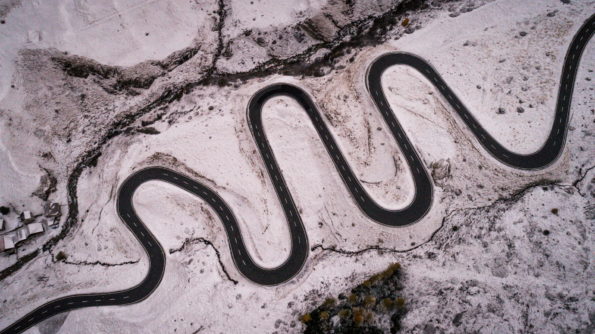
Chicanes and S-bends are where a driver has to rapidly change direction. Road designers try to separate curves with some straight road if possible, as shown above, as it allows for the vehicle to settle between turns. As a vehicle turns one way, its weight shifts to the outside of the corner. As it straightens up, the weight moves back to the centre of the vehicle. If the vehicle turns the other way as the weight is moving back, it can amplifies the effect of the centre of gravity shifting.
One road design which is a huge rollover risk for large, high-sided vehicles such as buses and trucks are roundabouts.
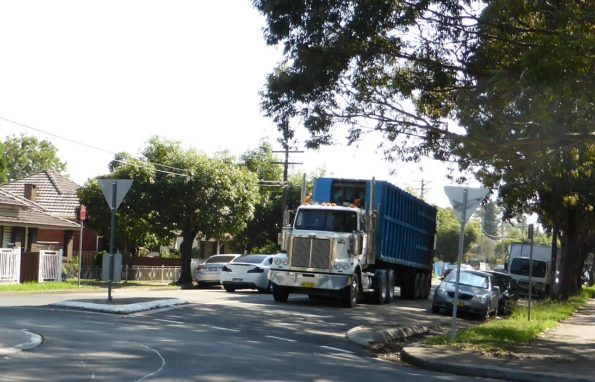
On a roundabout there is a rapid change in direction as the truck is turning right as it’s going around the roundabout, but has to turn left to get off the roundabout.
Camber
Camber is the slope of the road. Continuing the roundabout example from above, the road usually slopes towards the edge of the roundabout so that water drains away and doesn’t sit in the middle. This slope tips vehicles towards the outside of the curve, changing the centre of gravity and increasing the chance of a rollover, which can happen at surprisingly low speeds (as low as 5km/h)
Bumps
A bump on the inside of a corner can lift the inside wheel, throwing the centre of gravity further towards the outside of the curve.
Friction
If a vehicle hits a slippery patch and slides, but then suddenly regains grip, this can cause the centre of gravity to move too far to the side. This is effectively what happens in a motorbike high-side accident, too. Slippery patches can include areas of tar bleed or where sand or gravel are spilled on the road.
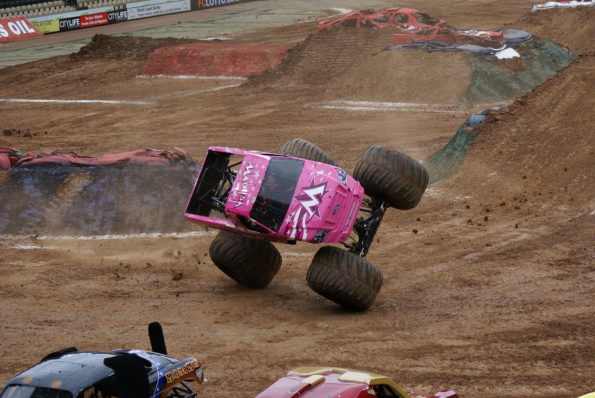
Areas exposed to wind
Flat plains, bridges and coastal roads are all exposed to strong winds at certain times as there’s nothing to break up the wind. Large buildings, forests and hills can create a wind shadow. When the vehicle emerges from the wind shadow, it’s hit by sudden gusts which can unbalance it and blow it over. This is especially dangerous if the wind is coming from the apex (inside) of a corner as the vehicle is already turning and therefore the centre of gravity is towards the outside of the corner.
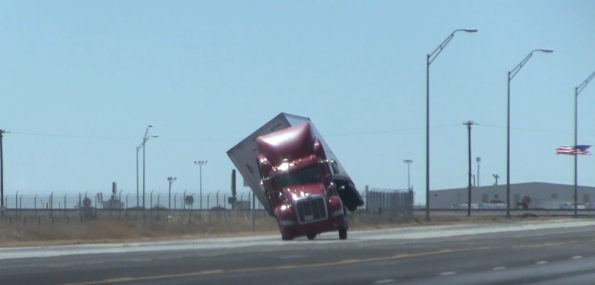
Signage is often displayed in areas where strong sidewinds are a risk.
Road edges
Vehicles venturing off the edge of the road increase their risk of rollover. Firstly, a kerb provides an obstacle that can bounce a vehicle up on one side and tip it over. Culverts and ditches, soft edges and unmown verges all increase the risks of a rollover, particularly with high-sided vehicles.
How does a rollover happen?
If an external object causes the rollover, it’s called ‘tripped’. If it’s caused by speed, friction and steering input, it’s called ‘untripped’.
An example of a tripped rollover accident is being blown over in strong winds.
An example of an untripped rollover accident is steering too quickly through a mini-roundabout, causing weight transfer that tips the vehicle over.
Speed and cornering line
Too much speed with too much steering input can cause a rollover, more so in heavy vehicles and high-sided light vehicles like vans rather than cars that have a lower centre of gravity.
Collision with another vehicle or object
Several scenarios can happen when one vehicle hits another:
- One vehicle pushes the other vehicle over (usually a large vehicle like a truck pushing a smaller vehicle over)
- A vehicle runs up over another vehicle – this is a risk for vehicles will tall suspension hitting another vehicle which is short as the short vehicle acts like a ramp
- The vehicle’s rotating wheels hit bodywork or rotating wheels on the other vehicle and the momentum lifts one of the vehicles; this is common in side-swipe accidents
- Small overlap crashes are where a vehicle hits another vehicle with only a small area of contact. The deformation of the vehicles creates a ramp scenario.
When a vehicle hits an object, that object can:
- act like a ramp
- deform the vehicle enough that it acts like a ramp
- catch part of the vehicle and cause that part to abruptly stop and the momentum is then transferred to rollover momentum
Weight transfer
As we alluded to above when talking about chicanes and roundabouts, the pendulum effect causes by changes in direction can become too much and the vehicle rolls over. This happens in the following scenarios:
- A live load (i.e. a load you are carrying which is not fixed to the vehicle) moves in a corner, amplifying the change in the centre of gravity – this is why it’s important to secure your load properly
- A vehicle does a sharp left/right or right/left turn. This can happen when avoiding an object in the road (e.g. an animal runs out), or when driving too quickly through a chicane or s-bend
- A vehicle starts to tip and the driver overcorrects and it tips back further the other way
Vehicle hits an obstacle or soft ground while travelling sideways
Sliding into soft ground where the wheels dig in will frequently cause a rollover to occur. The same happens if sliding into a kerb (unless the wheels buckle underneath the car)
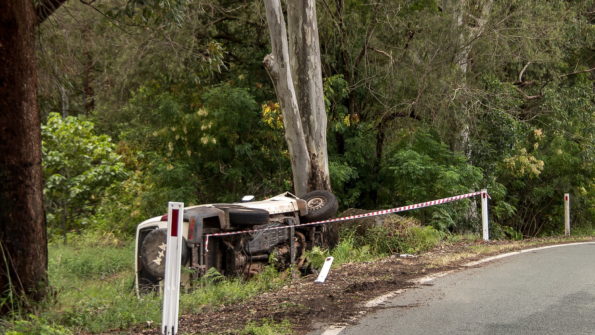
Ground is uneven or too steep
A slope of more than around 33% will usually cause a car to roll, but it’s much less for heavy vehicles.
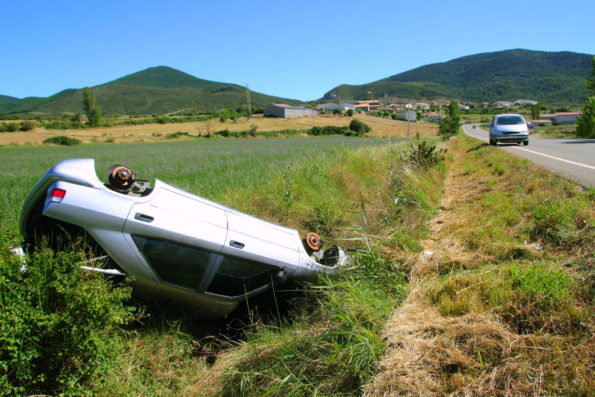
Jackknifing trailer
Trailer sway can cause the trailer to get so out-of-control that it pulls the towing vehicle around with it and tips it over.
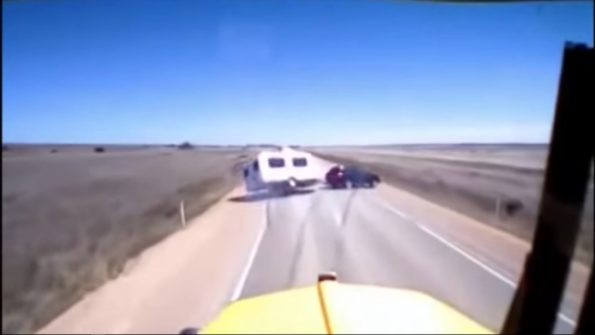
How can we eliminate rollovers?
Training
Some training companies provide rollover training. For example, TR Driver Training in New Zealand has a tanker with outriggers fixed.
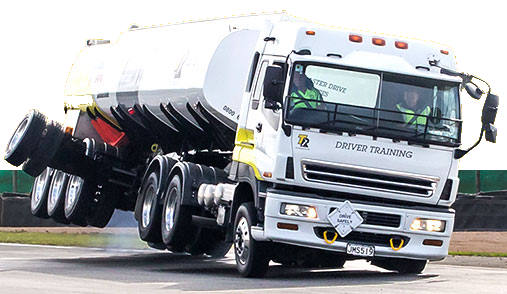
Other driver training can focus on choosing appropriate speeds, cornering lines and driving in bad weather and difficult conditions.
Technology and vehicle design
Electronic stability control and trailer sway mitigation reduce the risk of rollovers by helping the driver stay in control of the vehicle.
Manufacturers must also make vehicles that have a lower risk of rolling over.
Loading correctly
Heavy vehicle drivers and drivers pulling caravans and other light trailers must be aware of the centre of gravity of their load, and must secure the load so that it doesn’t move independently of the vehicle.
